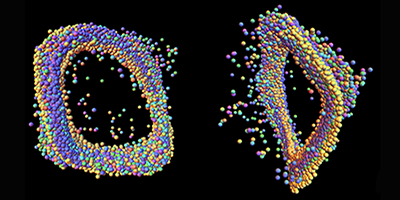February 4, 2015 report
Researchers find evidence of fractal behavior in pulsating stars

(Phys.org)—A team of researchers working at the University of Hawaii using data from the Kepler space telescope, has found that the oscillations made by a star conform closely to the golden mean—further study showed that it also behaves in a fractal pattern. In their paper published in the journal Physical Review Letters, the team describes their analysis of data from the pulsating star KIC 5520878, captured over a period of several years, and why what they found is cause for excitement.
In studying the Kepler data, the team was able to track the pulses that emanated from the star over a period of four years—taken at 30 minute intervals. They found that two of star KIC 5520878's pulsating frequencies occurred at 4.05 and a 6.41 hour cycles—which the team noted had a ratio of 1.58, which is close to 1.618, aka the Golden Ratio—famously found in nature and sometimes artistic renderings. Intrigued, they looked deeper and found that the frequencies conformed to fractal patterns—separating the oscillations into their constituent parts revealed additional weaker frequencies, similar to the way, the team points out, that images of shorelines display craggy lines regardless of how close or far away they are viewed from.
Counting bumps on converted plots which had heights greater than a certain threshold revealed a power law dependence—one of the accepted signs of fractal behavior. The difference here of course is that with traditional fractal systems, the behavior is seen visually—here it was seen as factor of time. The group suggests that their finding appears to be the first example of a "strange nonchaotic attractor" which is a system that displays a fractal structure but does not have the sensitivity to beginning conditions of other known chaotic systems, such as the weather.
The team looked at five other pulsating stars to see if they could spot a pattern and found mixed results, three of them had near golden ratios and fractal patterns, while two others had neither. What is still unclear at this point is whether the behavior of the stars that do show fractal structure is something that happens for a reason, which could perhaps offer new clues about stellar physics, or if the ratios found by the team are merely coincidence.
More information: Strange Nonchaotic Stars, Phys. Rev. Lett. 114, 054101 – Published 3 February 2015. dx.doi.org/10.1103/PhysRevLett.114.054101 . On Arxiv: arxiv.org/abs/1501.01747
ABSTRACT
The unprecedented light curves of the Kepler space telescope document how the brightness of some stars pulsates at primary and secondary frequencies whose ratios are near the golden mean, the most irrational number. A nonlinear dynamical system driven by an irrational ratio of frequencies generically exhibits a strange but nonchaotic attractor. For Kepler's "golden" stars, we present evidence of the first observation of strange nonchaotic dynamics in nature outside the laboratory. This discovery could aid the classification and detailed modeling of variable stars.
Journal information: arXiv , Physical Review Letters
© 2015 Phys.org










.gif)










